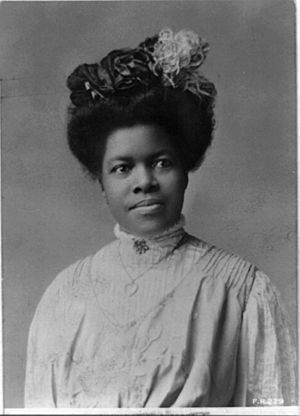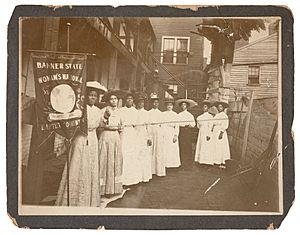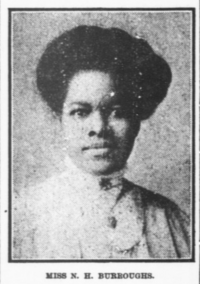Nannie Helen Burroughs facts for kids
Quick facts for kids
Nannie Helen Burroughs
|
|
|---|---|

Burroughs in 1909
|
|
| Born | May 2, 1879 Orange, Virginia, U.S.
|
| Died | May 20, 1961 (aged 82) Washington, D.C., U.S.
|
| Occupation |
|
| Known for | Founding the National Training School for Women and Girls |
Nannie Helen Burroughs (May 2, 1879 – May 20, 1961) was an important African-American educator, speaker, religious leader, and civil rights activist. She also ran her own businesses. She became famous in 1900 after giving a powerful speech called "How the Sisters Are Hindered from Helping" at the National Baptist Convention in Virginia.
In 1909, Nannie Helen Burroughs started the National Training School for Women and Girls in Washington, D.C. Her main goal was to help both African Americans and women gain more opportunities and equal rights. She worked at the school until she passed away in 1961. In 1964, the school was renamed the Nannie Helen Burroughs School in her honor. It became a school for both boys and girls. The school's Trades Hall, built in 1927–1928, is now a National Historic Landmark.
Contents
Early Life and Education
Nannie H. Burroughs was born on May 2, 1879, in Orange, Virginia. She was the oldest daughter of John and Jennie Burroughs. Both of her parents had been enslaved people. They worked hard to build a good life after they became free. Nannie's grandfather, Lija, was a carpenter who was able to buy his freedom during slavery.
When Nannie was about five years old, her younger sisters died. A few years later, her father, who was a farmer and a Baptist preacher, also passed away.
In 1883, Nannie and her mother moved to Washington, D.C. They lived with Nannie's aunt, Cordelia Mercer. D.C. offered better chances for jobs and education. Nannie went to M Street High School. While there, she started the Harriet Beecher Stowe Literary Society. She also studied business and home economics. At school, she met her role models, Anna J. Cooper and Mary Church Terrell. These women were active in fighting for voting rights for women and civil rights for African Americans.
After graduating with honors in 1896, Nannie wanted to be a home economics teacher in D.C. schools. However, she could not find a job. Even though it wasn't said directly, it was understood that she was refused because her skin was considered too dark. They preferred black teachers with lighter skin. This unfairness made Burroughs even more determined. She said she would "beat and ignore both until death." This strong feeling led her to create a training school for black women with lower incomes and social status.
Nannie Burroughs' Career
From 1898 to 1909, Nannie Burroughs worked in Louisville, Kentucky. She was an editorial secretary and bookkeeper for the Foreign Mission Board of the National Baptist Convention. While in Louisville, she helped form the Women's Industrial Club. This club offered classes in home economics and management.
Nannie Burroughs was also one of the founders of the Women's Convention. This group helped the National Baptist Convention. She served the Women's Convention for almost 50 years, from 1900 to 1947. She was president of the Women's Convention for 13 years.
The Women's Convention was very important for black religious groups. It was the largest gathering of African Americans at the time. The National Association of Colored Women (NACW), formed in 1896, also played a big role. Because of her work with the NACW, the National Association of Wage Earners was created. This group aimed to bring attention to the challenges faced by African-American women.
Burroughs was the president of the National Association of Wage Earners. Other famous women, like Mary McLeod Bethune and Maggie Lena Walker, were also leaders in this group. These women focused on educating the public rather than just union activities. Burroughs was also a member of other clubs, like the Ladies' Union Band. She was very active in the National Association for the Advancement of Colored People (NAACP).
In 1928, President Herbert Hoover appointed Burroughs to lead a committee on Negro housing. This was for the White House Conference of 1931 Home Building and Ownership, which happened right after the stock market crash of 1929 and the start of the Great Depression. In 1933, Burroughs gave a speech in Richmond, Virginia, called "How White and Colored Women Can Cooperate in Building a Christian Civilization."
Burroughs also wrote plays. In the 1920s, she wrote The Slabtown District Convention and Where is My Wandering Boy Tonight?. These were short plays for church groups. Slabtown was a funny and satirical play that became very popular. It was printed many times over the years.
Training School and Racial Uplift
Nannie Burroughs opened the National Training School in 1908. In its first few years, the school offered evening classes for women who couldn't get an education anywhere else. Burroughs herself taught these classes. At first, 31 students regularly attended. Over time, because of the high quality of teaching, more and more students came. The school started in a small farmhouse but soon attracted women from all over the country.
For the first 40 years of the 20th century, the National Training School prepared young African-American women to "uplift the race" and earn a living. The school focused on "the three B's: the Bible, the bath, and the broom." Burroughs also created her own history course. This course taught women about the important contributions of African Americans throughout history. Since this topic was not usually taught in schools, Burroughs felt it was important for African-American women to be proud of their heritage.
Nannie Helen Burroughs and her staff taught industrial skills along with lessons in morality, religion, and cleanliness. This helped African-American women deal with a big challenge. Many black women worked in service jobs in their communities. They were also seen as important guardians for the African-American community. The National Training School worked to change the unfair image of African Americans. It trained young African-American women to be good workers and community activists. This helped promote the idea of respectability, which was very important for "racial uplift"—meaning improving the standing of the entire race.
Respectability and a strong work ethic were key parts of the training at the National Training School. These qualities were seen as vital for African-American women to succeed as fundraisers, wage earners, and "race women." The skills learned at the school helped African-American women get involved in public life, including politics and helping their race. Burroughs used the idea of racial uplift to promote her school. Even though some people disagreed with her teaching women skills beyond just housework, students kept coming, and the school continued to grow.
Death and Legacy
Nannie Helen Burroughs passed away on May 20, 1961, in Washington, D.C., from natural causes. She never married, as she had dedicated her life to the National Trade and Professional School. She was buried at the Nineteenth Street Baptist Church, where she was a member.
Three years after her death, the school she founded was renamed the Nannie Burroughs School. It still carries her name today. More than 50 years after her passing, her story and achievements continue to inspire African-American women. The Library of Congress holds many of her papers, about 110,000 items.
- In 1907, she received an honorary Master of Arts degree from Eckstein Norton University. This was a historically black college in Kentucky.
- In 1964, the school she founded was renamed the Nannie Helen Burroughs School in her honor. Its Trades Hall is now a National Historic Landmark.
- In 1975, Mayor Walter E. Washington declared May 10 as Nannie Helen Burroughs Day.
- Nannie Helen Burroughs Avenue NE, a street in the Deanwood neighborhood of Washington, D.C., is named after her.
- In 1997, the National Women's History Alliance honored Burroughs during Women's History Month.
Images for kids
See also
 In Spanish: Nannie Helen Burroughs para niños
In Spanish: Nannie Helen Burroughs para niños






